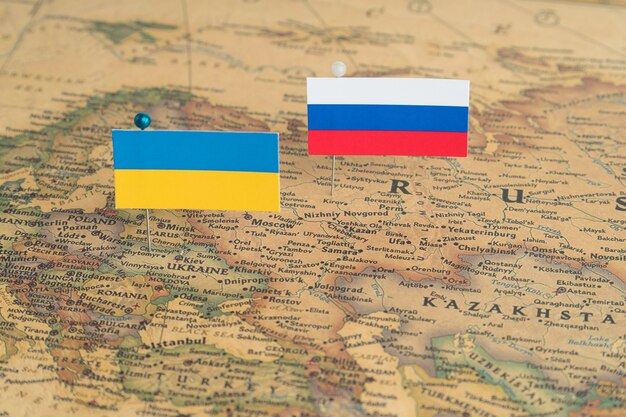US Role in Ukraine Conflict: Latest Developments & Outcomes

The United States’ multifaceted involvement in the Ukraine conflict encompasses extensive military, economic, and humanitarian aid, profoundly shaping the war’s trajectory and influencing potential geopolitical outcomes, presenting intricate diplomatic and strategic challenges for global stability.
The conflict in Ukraine continues to dominate global headlines, marking a pivotal moment in international relations. As the world witnesses the ongoing struggle, understanding the US Role in the Ukraine Conflict: Analyzing the Latest Developments and Potential Outcomes is crucial. This article delves into the intricate layers of American involvement, examining its evolution, impact, and the complex future landscape it helps to define.
Evolving US Engagement: From Initial Support to Strategic Partnership
The United States’ engagement in the Ukraine conflict has undergone a significant transformation since the full-scale invasion began, evolving from initial material support to a deep strategic partnership. This evolution reflects not only the escalating nature of the conflict but also a fundamental recalibration of US foreign policy in Eastern Europe and beyond.
Initially, Washington’s response focused on immediate humanitarian assistance and defensive weapons shipments, aiming to bolster Ukraine’s resilience against the unprovoked aggression. As the conflict progressed, the scale and sophistication of aid increased dramatically, signaling a long-term commitment to Ukraine’s sovereignty and territorial integrity. This commitment has been underpinned by consistent bipartisan support within the US Congress, illustrating a rare consensus on a significant foreign policy matter.
Key Milestones in US Support
- Early Defensive Aid: Provision of Javelin anti-tank missiles and Stinger anti-aircraft systems proved critical in the early stages, helping Ukraine repel initial Russian advances.
- Expanded Military Assistance: The shift towards advanced artillery, HIMARS systems, and eventually Patriot missile defense systems marked a qualitative leap in military backing, enabling Ukraine to strike deeper and defend critical infrastructure.
- Economic and Humanitarian Lifelines: Billions of dollars in direct budgetary support, alongside humanitarian aid packages, have been essential in keeping the Ukrainian economy afloat and alleviating the civilian toll.
The strategic partnership forged amidst the conflict extends beyond military and financial aid. It includes intelligence sharing, cybersecurity cooperation, and robust diplomatic coordination with European allies. This integrated approach aims to maximize the collective impact against Russian aggression while minimizing the risk of direct escalation between NATO and Russia. The sustained nature of this collaboration highlights a deliberate strategy to empower Ukraine to defend itself and ultimately secure a favorable position in any future peace negotiations.
As the conflict enters new phases, the US role continues to adapt, driven by battlefield realities and geopolitical shifts. The emphasis remains on providing Ukraine with the tools necessary to defend its territory and people, avoiding mission creep while ensuring that the cost of aggression far outweighs any perceived gains. This adaptive strategy underscores the dynamic nature of US involvement, positioning it as a pivotal actor in shaping the conflict’s present and future trajectories.
The Impact of US Military Aid on Battlefield Dynamics
The provision of US military aid has undeniably altered the battlefield dynamics in Ukraine, empowering its forces to defend against and even push back Russian advances. This assistance has not been merely supplementary but has often introduced capabilities previously unavailable to the Ukrainian military, enabling them to execute complex operations and sustain their defense against a numerically superior adversary.
A prime example of this impact is the High Mobility Artillery Rocket System (HIMARS), which allowed Ukraine to target Russian command centers, logistics hubs, and ammunition depots far behind the front lines, disrupting their supply chains and degrading their operational capabilities. Similarly, advanced air defense systems like the Patriot have provided crucial protection against relentless missile and drone attacks, safeguarding critical infrastructure and civilian lives.
Technological Superiority and Training
- Precision Weaponry: Systems such as JDAM kits and ATACMS missiles have given Ukraine the ability to strike with greater accuracy and at longer ranges, disproportionately affecting Russian military assets.
- Battlefield Intelligence: Enhanced intelligence sharing from US sources has provided Ukrainian commanders with vital insights into Russian movements and intentions, facilitating more effective defensive and offensive operations.
- Military Training Programs: Extensive training provided by US and allied forces has equipped Ukrainian soldiers with the skills to operate sophisticated weaponry and adopt modern tactical concepts, enhancing their overall combat effectiveness.
The consistent flow of diverse military equipment, from armored vehicles and tanks to small arms and ammunition, has been instrumental in replenishing Ukraine’s defense stocks and maintaining operational continuity. This sustained support has prevented the collapse of Ukrainian defenses in key areas and allowed for counter-offensive operations that have reclaimed significant territory. The strategic deployment of Western-supplied armaments has forced Russia to adapt its tactics, often exposing vulnerabilities in its own military doctrine and logistical capabilities.
Moreover, the psychological impact of unwavering US military backing on Ukrainian morale cannot be overstated. It reinforces the belief that international support will continue, fueling determination and resilience among both soldiers and the civilian population. While the conflict remains fluid and unpredictable, the transformative effect of US military aid on Ukraine’s defensive posture and offensive potential is a well-established fact, profoundly influencing the struggle’s trajectory.
Economic Sanctions and Their Geopolitical Ramifications
The United States, in conjunction with its allies, has imposed an unprecedented suite of economic sanctions on Russia, aiming to cripple its economy and diminish its capacity to wage war. These measures target various sectors, including finance, energy, technology, and key individuals, with the intention of isolating Russia from the global economic system. The geopolitical ramifications of these sanctions are extensive, influencing not only Russia’s domestic affairs but also international trade, energy markets, and diplomatic relations worldwide.
Initially, the sanctions caused significant disruption to the Russian economy, leading to a sharp devaluation of the ruble and an exodus of foreign companies. However, Russia has demonstrated a degree of resilience, adapting by reorienting trade towards countries less aligned with Western policies and implementing measures to stabilize its financial system. This adaptability highlights the complex challenge of using economic pressure as a primary tool of foreign policy, especially against a large, resource-rich nation.

Far-Reaching Economic Consequences
- Global Energy Market Volatility: Restrictions on Russian oil and gas exports have led to significant price fluctuations, impacting consumers and businesses globally, and accelerating the search for alternative energy sources.
- Supply Chain Disruptions: Sanctions and counter-sanctions have exacerbated existing disruptions in global supply chains, affecting the availability and cost of various goods.
- Inflationary Pressures: The cumulative effect of energy price surges and supply chain issues has contributed to inflationary pressures in many economies, complicating central banks’ efforts to maintain price stability.
Beyond the immediate economic effects, the sanctions have profound geopolitical implications. They have deepened the divide between Western nations and a bloc of countries that either openly support Russia or maintain neutral stances, leading to a more fractured global economic order. The effectiveness of sanctions as a deterrent or coercive tool is a subject of ongoing debate among policymakers and economists, with some arguing for their long-term corrosive effect and others pointing to their limited immediate impact on Russia’s war machine.
Moreover, the sanctions regime has prompted a reassessment of economic interdependence and national security, encouraging countries to diversify their supply chains and reduce reliance on single sources of critical resources. While the full long-term impact on Russia’s economy and its global standing is still unfolding, the extensive use of economic statecraft by the US and its allies has undoubtedly reshape the contours of international relations and global economic governance.
Humanitarian Aid and Reconstruction Efforts: Beyond Military Support
Beyond the critical military and economic assistance, the United States has also been a leading provider of humanitarian aid to Ukraine, addressing the immense human cost of the conflict. This facet of US involvement underscores a commitment to alleviating suffering and supporting long-term recovery, recognizing that the war’s devastation extends far beyond the battlefield. Humanitarian aid encompasses a wide array of support, from emergency relief to psychological assistance and efforts towards future reconstruction.
Millions of Ukrainians have been displaced internally or have sought refuge in neighboring countries, creating an urgent need for shelter, food, medical care, and clean water. US agencies, in collaboration with international and local partners, have channeled significant resources to meet these immediate needs. This aid is crucial for sustaining the civilian population, particularly in areas directly affected by hostilities or under occupation.
The focus on humanitarian assistance also includes providing psychosocial support for those traumatized by the conflict, as well as demining efforts to clear contaminated areas and prevent civilian casualties. These initiatives are foundational for any future return to normalcy and rebuilding. The commitment to humanitarian aid highlights a comprehensive approach to the conflict, acknowledging the multifaceted challenges faced by Ukraine and its people.
Areas of Humanitarian Focus
- Emergency Relief: Provision of food, water, temporary shelter, and sanitation facilities for displaced populations and those in war-affected zones.
- Medical Assistance: Supply of medical equipment, medicines, and support for healthcare infrastructure strained by the conflict.
- Winterization Efforts: Crucial aid to help Ukrainians cope with severe winters, including provision of heating supplies, blankets, and repairs to damaged homes.
As discussions shift towards post-conflict recovery, the US has also begun to engage in preliminary reconstruction planning. While large-scale reconstruction efforts are contingent on the cessation of hostilities, the groundwork for long-term recovery is already being laid. This involves assessing damage, identifying priority sectors for rebuilding, and coordinating with international partners to ensure a cohesive and effective reconstruction strategy. The scale of destruction suggests that reconstruction will be a monumental and costly undertaking, requiring sustained international commitment for decades.
The humanitarian and reconstruction efforts illustrate a broader commitment to Ukraine’s future, moving beyond immediate military objectives to address the comprehensive needs of a war-torn nation. This holistic approach signals a recognition that true recovery involves not only security but also the restoration of livelihoods, infrastructure, and the social fabric of Ukrainian society.
Diplomatic Efforts and Alliance Management
A crucial, yet often less visible, aspect of the US role in the Ukraine conflict is its extensive diplomatic engagement and meticulous management of alliances. From the outset, Washington has prioritized a unified international response to Russian aggression, understanding that a fragmented front would undermine efforts to support Ukraine and deter further escalation. This has involved relentless shuttle diplomacy, coordination meetings, and strategic communications with a wide array of global partners.
The US has worked tirelessly to strengthen NATO’s eastern flank, reinforcing collective defense commitments and integrating new members like Finland and Sweden. These actions send a clear message of deterrence to Russia, emphasizing the unwavering commitment to Article 5 of the NATO treaty. Beyond NATO, the US has engaged with the G7, the European Union, and other international bodies to forge consensus on sanctions, aid packages, and diplomatic resolutions.
Managing allied interests and perspectives, which are not always perfectly aligned, has been a delicate balancing act. Economic dependencies on Russia, differing historical experiences, and varying degrees of perceived threat have necessitated nuanced diplomatic approaches. Yet, the US has largely succeeded in maintaining a strong, cohesive front against Russian aggression, leveraging its leadership to bridge divides and foster common purpose.
Key Diplomatic Objectives
- Maintaining Coalition Unity: Ensuring continuous alignment among allies on sanctions, military aid, and diplomatic strategies despite internal pressures and differing national interests.
- Deterrence and De-escalation: Communicating clear red lines to Russia while avoiding direct military confrontation between NATO and Russian forces, balancing support for Ukraine with strategic restraint.
- Global Diplomatic Isolation of Russia: Working to diminish Russia’s influence on the international stage and rally support for Ukraine’s territorial integrity in multilateral forums.
Diplomatic efforts also extend to communication with Russia, albeit through limited channels, aimed at de-escalation and managing risks. While direct negotiations on the conflict’s resolution remain elusive, these channels serve to prevent miscalculation and to convey firm resolve against further aggression. The long-term goal of these diplomatic endeavors is to secure a just and lasting peace that respects Ukraine’s sovereignty and international law.
The success of US diplomatic efforts and alliance management will ultimately determine the sustainability of international support for Ukraine and the shape of the post-conflict global order. It reflects a profound recognition that complex international crises require not only military and economic might but also astute diplomacy and unwavering commitment to multilateral cooperation.
Potential Outcomes and the Path Forward
Analyzing the potential outcomes of the Ukraine conflict, with particular attention to the US role, involves navigating a complex web of military, political, and economic variables. The path forward is fraught with uncertainties, yet certain scenarios and considerations are beginning to crystallize, influencing strategic planning in Washington and allied capitals. The immediate outcome hinges on the battlefield, but the long-term implications stretch far beyond Ukraine’s borders.
One potential outcome is a protracted conflict, resembling a frozen or simmering war, where neither side achieves a decisive victory. In this scenario, the US would likely continue its multifaceted support for Ukraine, adjusting aid levels based on battlefield needs and evolving geopolitical considerations. The economic burden on all parties, including aid providers, would remain significant, and the risk of sporadic escalations would persist.
Another scenario envisions a negotiated settlement, potentially involving concessions from both sides. The US role here would be pivotal in facilitating diplomatic processes, ensuring Ukraine’s voice is heard, and leveraging its influence to shape the terms of any peace agreement. The challenge would be to secure a durable peace that guarantees Ukraine’s sovereignty while addressing Russia’s security concerns, a delicate balance.

Key Factors Influencing Outcomes
- Sustained International Support: The continuity and scale of military, economic, and humanitarian aid from the US and its allies will be crucial for Ukraine’s ability to resist and negotiate effectively.
- Internal Russian Dynamics: Political stability within Russia, public opinion, and the elite’s perception of the war’s costs could significantly influence Moscow’s willingness to engage in serious negotiations.
- Global Geopolitical Shifts: Developments in other regions, especially in US-China relations or within energy markets, could divert attention or resources, affecting the conflict’s trajectory.
A third, less likely but significant, outcome involves a decisive military victory for one side. Should Ukraine achieve a significant breakthrough, the US role would shift towards supporting post-conflict stabilization, reconstruction, and potentially Ukraine’s eventual integration into Western structures. Conversely, a major setback for Ukraine would necessitate a reassessment of US strategy, potentially intensifying diplomatic efforts or increasing armament flows.
Regardless of the immediate military outcome, the conflict has already fundamentally reshaped global security architecture. The US role will continue to be crucial in managing the consequences, reinforcing international norms, and rebuilding a more stable and secure global order. The emphasis will inevitably shift towards long-term deterrence, arms control, and addressing the broader implications of geopolitical competition.
The path forward for Ukraine and the international community remains uncertain, but the US will undoubtedly continue to play a central role, adapting its strategies to meet evolving challenges and pursuing an outcome that aligns with its strategic interests and democratic values.
| Key Aspect | Brief Description |
|---|---|
| ⚔️ Military Aid Impact | US military aid, including HIMARS and Patriot systems, significantly altered battlefield dynamics, enhancing Ukraine’s defensive and offensive capabilities. |
| 💸 Economic Sanctions | Extensive US-led sanctions aim to cripple Russia’s economy, leading to global energy volatility and supply chain disruptions, yet Russia shows resilience. |
| 🤝 Diplomatic Leadership | The US plays a vital role in maintaining allied unity, NATO strength, and global diplomatic pressure against Russian aggression. |
| 🔮 Future Outcomes | Potential outcomes range from protracted conflict to negotiated settlement, with the US remaining central in shaping post-conflict stability and fostering global security norms. |
Frequently Asked Questions About the US Role in the Ukraine Conflict
The financial commitment of the United States to Ukraine since the full-scale invasion has exceeded tens of billions of dollars. This includes military, economic, and humanitarian assistance, making the US the largest single donor to Ukraine’s defense and recovery efforts. The aid is provided through various legislative packages and executive actions, reflecting sustained bipartisan support.
US military aid is transported to Ukraine primarily through European logistical hubs and then moved across the border. The process involves extensive coordination with NATO allies and partners. While specific tracking details are classified for security reasons, the US Department of Defense and other agencies employ robust oversight mechanisms to ensure accountability for the delivered equipment.
The primary goals of US sanctions against Russia are multifaceted: to degrade Russia’s military-industrial complex, reduce its capacity to fund the war, isolate its economy from global financial systems, and pressure the Kremlin to cease its aggression against Ukraine. They also aim to deter other potential aggressors and uphold international norms and laws.
The United States has consistently stated that it will not engage in direct military intervention in Ukraine, meaning no US boots on the ground or direct aerial combat with Russian forces. This stance is aimed at avoiding a direct conflict between NATO and Russia, which could lead to a broader, potentially catastrophic, escalation. Support remains focused on arming and training Ukrainian forces.
The US views any potential peace settlement as one that must uphold Ukraine’s sovereignty and territorial integrity, based on principles of international law. Washington emphasizes that any diplomatic solution must be determined by Ukraine itself, refraining from imposing terms. The US aims to ensure Ukraine is in the strongest possible negotiating position when the time for talks arrives.
Conclusion
The United States’ involvement in the Ukraine conflict is a complex, evolving tapestry woven with threads of military assistance, economic pressure, humanitarian support, and intricate diplomatic maneuvering. From bolstering Ukraine’s defenses with advanced weaponry to leading global efforts to sanction Russia and manage a delicate web of alliances, the US role has been instrumental in shaping the conflict’s trajectory and the international response. As the war continues to unfold, Washington’s commitment remains steadfast, aimed at securing a sovereign and democratic Ukraine and reinforcing the principles of international law. The implications of this sustained engagement will undoubtedly resonate for years to come, profoundly influencing the global geopolitical landscape and underscoring the enduring significance of American leadership in times of crisis.





